The healthcare sector has now become digitized by embracing technology solutions such as Electronic Medical Records (EMR) Software, billing solutions, patient scheduling software, and many more. Automation brings with it the benefits of increased efficiency, streamlined workflows, and improved patient care.
How can EMR Software decrease Operational Costs for Practices?
When EHR solutions are implemented correctly and optimized they can reduce overall operational costs.
Enhanced Efficiency
Tedious and daily administrative processes such as patient data entry, patient scheduling, and financial billing are automated with software technology. This reduces the amount of paperwork involved and eliminates errors which can lead to lower labor costs.
Physical Storage is Reduced
Large physical storage areas for paper medical records are no longer necessary thanks to Electronic Health Records software. This not only frees up space but also lowers the price of organizing, keeping, and retrieving paper records.
Benefits of Interoperability
The use of EMR Software results in the smooth exchange of patient data within a network of healthcare providers. By doing so, redundant testing is decreased, needless treatments are avoided, and care coordination is improved. Lower expenses for both patients and healthcare providers result from fewer repeat testing.
EHR Technology Can Save Time
The following time-saving features in the software can reduce workloads and decrease costs:
- Seamless integration between Practice Management (PM) Software and Scheduling solutions.
- Customizable templates and charting tools can streamline the documentation process.
- Quick search features to retrieve critical patient data in real-time.
- E-Prescribing (e-Rx) tools reduce the chances of errors.
Workflow optimization and Regulatory Compliance with EMR Software
Certain EMR Software vendors such as athenahealth EMR Software, Cerner, and Epic Solutions offer customized solutions to fit certain healthcare processes, cutting down on time wasted on unnecessary tasks and increasing the effectiveness of the care process as a whole. The increased productivity that results from this optimization can result in cost savings.
Moreover, electronic medical records software frequently incorporates capabilities to assist with healthcare regulatory compliance. This decreases the possibility of fines or penalties for noncompliance which can reduce costs for healthcare organizations.








